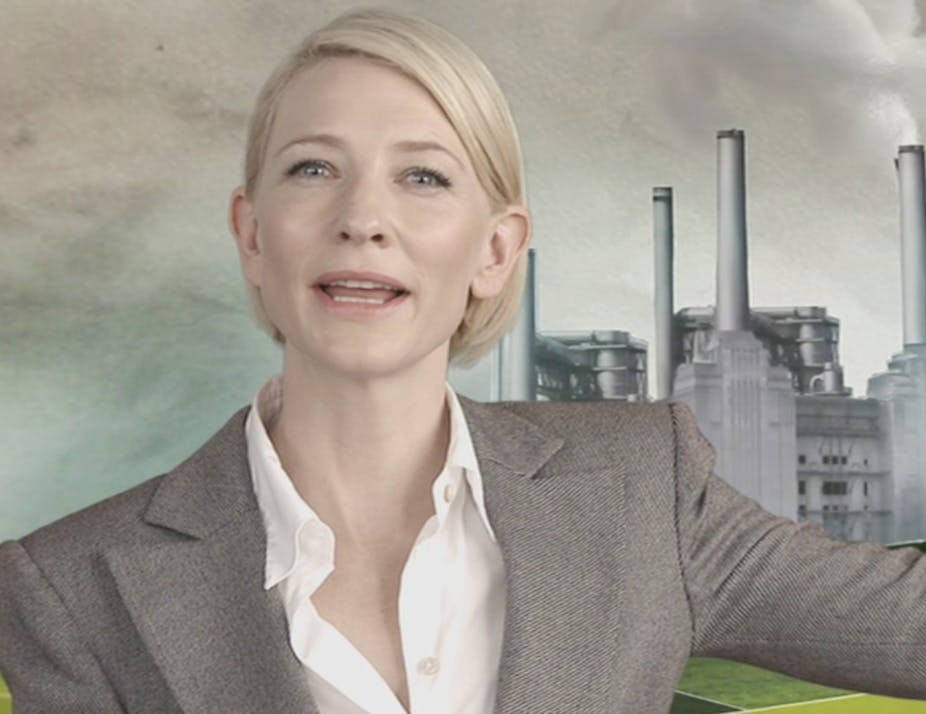Cate Blanchett possibly got more than she bargained for this week when she was caught up in a backlash over her appearance in a campaign calling for Australians to support a carbon price.
Blanchett, a renowned and wealthy international actress, was dubbed “Carbon Cate” and vociferously attacked by some media commentators for taking part in the “Say Yes to a Price on Carbon” campaign, organised by 140 prominent Australians and community groups.
Just how well does celebrity endorsement work? Using models and celebrities to give endorsements and act as spokespeople has made up a large part of marketing imagery since the late 1970s.
Marketing and advertising research has shown that the person making the endorsement can have a significant effect on how persuasive the message is.
Celebrity endorsers are also used because they are often viewed as dynamic, attractive and likeable, with their fame bringing attention to the product or brand.
But selecting an appropriate celebrity to endorse a product is a crucial decision - often as it can be extremely expensive - but also because the characteristics of the product or brand must match-up the image conveyed by the celebrity if you want a positive impact. This is what is known in marketing theory as the “match-up hypothesis”.
Marketing studies show the most common traits accompanying congruence include credibility, attractiveness, trustworthiness, and expertise.
Others deserve mention – objectivity, qualification, competence, likeability, character and believability.
Although Cate and her co-stars were aiming to refocus the debate on the moral and environmental benefits of a carbon price, she in particular was accused of by conservative politicians for being “out of touch”.
“You do not give special weight to people who live half the year in Hollywood where there is no carbon tax,” Opposition Leader Tony Abbott was reported as saying.
This is classic incongruence. The inference is Blanchett is an actress with no particular expertise in the area of climate change. (Although the actress told Fairfax media outlets she has been a member of the Conservation Foundation for several years.)
However, when Al Gore spoke about global warming, consumers were quite receptive as he was considered to have the required expertise.
As a wealthy actress, it could be perceived Cate doesn’t “match-up” to “battlers” who would be affected by higher living costs that may be associated with carbon price – even though Blanchett says she was not paid for her appearance in the campaign.
Another problem is that it is naive to believe consumers will be supportive of a message simply because a celebrity is used.
One wouldn’t purchase a fridge without product information simply because a celebrity encouraged us to do so.
If we reflect on the conditions under which models are appropriate for products and look to the pro-carbon tax campaign, one could argue that there is a perceived lack of credibility, trustworthiness and expertise, which in turn may explain the negative perceptions of the campaign.
The same can be said for Shane Warne and Nicorette, Tiger Woods and Gillette. On the other hand, Michael Jordan and Nike and Michael J Fox and Mohammad Ali for the Parkinson’s Foundation possess that perfect fit.
The average person is now exposed to up to 5000 advertisements a day, compared to 500 back in the 1970s, so it is easy to understand why today’s consumer is particularly advertising savvy.
Social media has turned us into experts with the possibility to voice our opinions and promote them all to a worldwide audience.
This enables consumers to immediately place messages under the public microscope, which is why it’s crucial to really understand the audience and to reflect the characteristics that lead to a successful campaign – trustworthiness, credibility, attractiveness, and expertise.
The world of marketing is very different to what it was five years ago, with time-starved consumers more likely to be influenced by someone in their social network than a weak celebrity endorsement.
Products and brands can no longer be pushed into the consumer’s world. They need to invite the consumer in.

